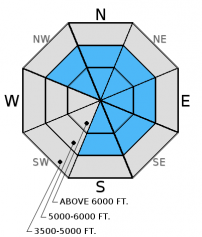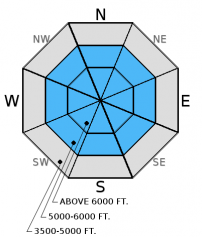| Monday | Monday Night | Tuesday | |
|---|---|---|---|
| Cloud Cover: | Building high pressure. | Continued clearing. | Warming. |
| Temperatures: | 32-41 deg. F. | 15-32 deg. F. | 35-43 deg. F. |
| Wind Direction: | SW | SW | S-SW |
| Wind Speed: | 6-8 | 5-8 | 3-9 gusts 24 |
| Snowfall: | 0 in. | 0 in. | 0 in. |
| Snow Line: |
Whitefish Range
Swan Range
Flathead Range and Glacier National Park
How to read the forecast
The avalanche danger will rise to CONSIDERABLE on all slopes above 6000 feet. Warming temperatures combined with solar input will stress the cold dry surface snow with wet loose avalanches and cornice failures possible. Also, recent strong winds drifted snow and created wind slabs on leeward slopes and cross-loaded terrain features on multiple aspects. Human triggered avalanches are likely. All other terrain has a MODERATE danger.

3. Considerable
?
Above 6500 ft.
2. Moderate
?
5000-6500 ft.
2. Moderate
?
3500-5000 ft.
- 1. Low
- 2. Moderate
- 3. Considerable
- 4. High
- 5. Extreme
-
Type ?
-
Aspect/Elevation ?

-
Likelihood ?CertainVery LikelyLikelyPossible
 Unlikely
Unlikely -
Size ?HistoricVery LargeLargeSmall

Today's warming temperatures and increasing solar radiation will stress our relatively cool dry surface snow at all elevations. This week will be the first substantial warming our snowpack has seen since early January and, due to the angle of the sun, should be more intense than that event. On sunny aspects, depending on the amount of solar input, the snow surface can quickly break down as the day progresses. Therefore expect instabilities to begin on easterly aspects, followed by southerly, westerly and perhaps even north facing slopes. The first sign of unstable snow will be rollerballs/pinwheels. Skiing and riding conditions can deteriorate quickly and when this occurs you have overstayed your welcome. Wet loose slides can put a lot of stress (weight) on the snowpack and trigger deeper instabilities.
-
Type ?
-
Aspect/Elevation ?

-
Likelihood ?CertainVery LikelyLikelyPossible
 Unlikely
Unlikely -
Size ?HistoricVery LargeLargeSmall

The wind event our area experienced Friday/Saturday was possibly the most impressive of the season. Moderate to strong winds drifted recent snow and formed wind slabs on multiple aspects at both mid and upper elevations. Warm temperatures on Sunday has initiated the strengthening process within these slabs. However, due to their thickness and wide distribution, these slabs will require additional time to completely heal. In some areas these slabs formed over a recently buried layer of surface hoar (formed 2/3). In these areas instability will linger and avalanches have the potential to propagate far and wide. Look for obvious signs of instability like shooting cracks, whumpfing, and recent avalanche activity. Look for convex pillows of wind drifted snow on the lee sides of ridges and other cross-loaded terrain. Carefully evaluate all wind loaded terrain before traveling on or underneath the slope.
-
Type ?
-
Aspect/Elevation ?

-
Likelihood ?CertainVery LikelyLikelyPossible
 Unlikely
Unlikely -
Size ?HistoricVery LargeLargeSmall

Buried surface hoar now about 6 inches to a foot from the surface has produced the most recent activity, but is spotty in distribution. Deeper layers like the weak snow surrounding the the January 17 and January 28 rain crusts are buried 1.5-2.5 feet deep. Recent stability tests suggest that these deeper persistent slabs are gaining strength and are becoming more difficult to trigger. With that said it remains important to perform site specific snowpack evaluation. Dig in the snow and do a stability test, look for locally reactive slabs. Where they are present and there is any question about stability choose conservative terrain to ski or ride in. Avoid areas where you are more likely to affect these layers like in shallow snow and in steep, rocky areas.
Recent strong winds created substantial cornice formation throughout our advisory area. Forecasted warm temperatures and sunshine will weaken these cornices today and through the week. This is not the time to ride or ski on or below these features. Cornice falls have the ability to trigger avalanches on any layer of concern in the snowpack (e.g. surface wet loose, wind slabs, persistent slabs). Cornices are referred to as the "bombs of the backcountry" and this is the time to give them a wide berth.
The final report for the 1/23/2016 avalanche fatality in Swede Creek in the Whitefish Range is complete and located here: http://www.flatheadavalanche.org/sites/default/files/20160124_swedecreekavalaccidentreport_final.pdf.
Sunday: Skiers in the Apgar Range in southern Glacier Park noted numerous cornice failures along with possible wet slide debris at lower elevations. Wind slabs varied between non reactive to somewhat reactive. Skiing at lower elevations was "heavy and sloppy" (observation). The Patrol Fund Level 1 avalanche course at WMR in the southern Whitefish Range were able to get failure below the late January crust in compression tests with hard force. They also noted new surface hoar growth overnight (observation).
Saturday: Snowmobilers in the Stahl Peak area in the northern Whitefish Range observed recent natural avalanche activity. They noted wind drifting the snow at all elevations. While side hilling on a road cut they experienced cracking in the windslab 10-20cm deep (observation). We were in the Red Meadow area also in the northern Whitefish Range. Wind was drifting snow and forming wind slabs at all elevations (photo, video), and large cornices were developing along leeward ridgelines. We found weak snow around the January 28 crust that fractured in stability tests without propagation (observation).
Friday: Skiers in Crystal Creek/Stanton Lake in the Flathead Range intentionally triggered a windslab from the ridgeline (photo). They also noted active windloading forming slabs thicker than 2 feet deep (observation). Skiers on Snowshed Mountain also in the Flathead Range observed light winds with minimal drifting due to scoured windward slopes. They did note evidence of recent wind loading as knee deep soft slabs had formed on leeward slopes. Stability tests produced fractures with hard force on weak snow surrounding crusts 1.5-2 feet deep. They did not observe recently formed buried surface hoar in this location (observation). Snowmobilers in the 6-Mile area in the Swan Range noted substantial recent windloading. They did not see recent avalanche activity, but did experience other obvious signs of instability like cracking and collapsing (whumphing).
Thursday: Erich and I rode into Doris Ck. yesterday and were a bit suprised to see how much wind affected snow existed at elevations below 5000 ft. While the slabs weren't terribly large (6-10 inches deep), this clearly shows that they are thicker at mid and upper elevations. We also observed shooting cracks on small test slopes less than 35 degrees (observation, video). Skiers in the Essex Creek area of the Flathead Range also reported strong to extreme (>38 mph) winds with loose snow sluffs and shallow slabs on steep slopes as well (observation). Skiers in the Wahoo/Cascadilla area in the Flathead Range observed widespread cracking, shallow slabs at lower elevations, and signs of instability at all elevations as well.
Wednesday: Erich toured in Skookoleel and Lakalaho Creeks in the southern Whitefish Range yesterday where they found variable results in our numerous stability tests in a number of different pit locations (video, observation). They also found 3-5 mm surface hoar that formed Tuesday night. Skiers in the Middle Fork of the Flathead Range also observed surface hoar and a few layers in the upper snowpack that produced fracture in their stability tests (observation).
Visit our Observations page and our You Tube channel for more observations from the entire season.
Thanks to everyone for submitting observations. They are extremely useful and could help save lives.
HOW TO SUBMIT OBSERVATIONS:
Email: [email protected]
Call and leave a message: 406.387.3821
You can also submit quick observations via text: 406.241.4571 (FAC mobile)
OR
Submit Snowpack Observations: http://www.flatheadavalanche.org/node/add/snowobs
Submit Avalanche Observations: http://www.flatheadavalanche.org/node/add/avyobs
High pressure has built into our area. Yesterday was mostly sunny with light winds, no precipitation and slightly warmer than seasonal temperatures. Today expect temperatures to rise to above freezing at all elevations. This morning temps currently range from the mid 20's to 30 F with light winds and partly cloudy skies. Partly cloudy conditions are expected for low and mid elevations with clearing at ridgeline elevations..
| 0600 temperature: | 23 -31 deg. F. |
| Max. temperature in the last 24 hours: | 26-31 deg. F. |
| Average wind direction during the last 24 hours: | SW |
| Average wind speed during the last 24 hours: | 5-15 mph |
| Maximum wind gust in the last 24 hours: | 10-20 mph |
| New snowfall in the last 24 hours: | 0 inches |
| Total snow depth: | 63-94 inches |
This advisory applies only to backcountry areas outside established ski area boundaries. This advisory describes general avalanche conditions and local variations always occur. This advisory expires at midnight on the posted day unless otherwise noted. The information in this advisory is provided by the USDA Forest Service who is solely responsible for its content.









































